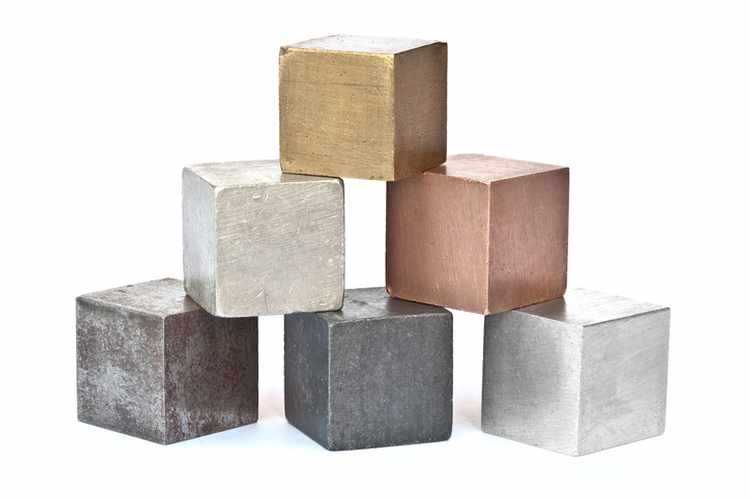Digital Alloys’ Guide to Metal Additive Manufacturing - Part 17
What Metals Can You Print?
March 11th, 2020

The products we use every day contain thousands of different metals, each selected for their balance of cost, performance, and manufacturability. All conventional metal manufacturing processes, from casting to stamping, are limited in the alloys they can manufacture (material compatibility). Additive manufacturing (AM) processes are no different. Each metal AM process has distinct sets of materials with which it is compatible, and this determines the applications that are viable for each process.
Materials are usually chosen early in the product development process. The compatibility of these materials with manufacturing methods is essential to selecting a viable material and process combination. Successfully implementing metal AM requires an understanding of which processes and metals are compatible, today and in the future. This post highlights material compatibility for the most popular metal AM technologies, and discusses the most important factors influencing compatibility.
The below table summarizes which metals are commercially available (green) and in development / proven in a lab environment (yellow) for popular AM processes:
A metal’s compatibility with an AM process is dependent on three factors:
1) Feedstock Manufacturing: the metal must be able to be processed into a feedstock of suitable type and quality for the AM process;
2) Printability: the feedstock material must behave acceptably during the manufacturing process; and
3) As-Printed State: the final quality and state (hardness, grain size, etc.) of the printed material must meet requirements.
Feedstock Manufacturing
Powder and wire are the primary feedstocks for most metal AM processes. Wire is produced by drawing a metal rod through a die; a process that is compatible with most metals. Wire is commercially available in a very wide range of metals.
Powder-based metal AM processes often have stringent requirements on the powder’s size and shape (morphology). Due to these requirements, metal AM powders are typically produced through slow, expensive atomization processes (diagrams below), limiting the supply and range of metals produced.
Gas Atomization (left) & Plasma Atomization (right) – source: AM Metal Magazine
Printability and the As-Printed State
Metal AM technologies use a wide range of different processing conditions. These include the physics governing the movement of material and energy, and the dynamics of melting and solidification. Please see our post on The Physics of Metal AM.
The most common metal AM process challenge is the rapid melting and cooling cycles which produce large temperature gradients. When materials heat and cool they expand and shrink, creating residual stresses that can cause metals to warp and/or crack. This same challenge exists in welding. As such, the weld-ability of a material often predicts whether a metal is compatible with AM processes. The exceptions to this test are binder jetting, where the whole part is sintered in one post processing step, and cold spray, which is a low-temperature, steady-state process. Below we provide more detail on metal printability and the as-printed state for popular metal AM processes.
PBF is characterized by high-energy welding of a powder bed. In a typical part, this small line-width process produces the equivalent of miles of welded toolpath. This results in the printed material seeing many cycles of melting and solidification. The rapid solidification rates and large thermal gradients make PBF prone to anisotropic and small-grain microstructures as well as micro-cracking. These effects are especially pronounced in low ductility materials that cannot accommodate high stresses. One expert notes that PBF’s “microscopic defects often constrain the types of alloys that can be printed effectively, and limit the mechanical performance of those that can” (source: Metal AM Magazine).
Another PBF process compatibility challenge is the absorption/reflectivity of the heat source. Highly reflective materials such as copper require machines with special wavelength lasers to increase energy absorption into the powder being melted.
http://www.scielo.br/scielo.php?script=sci_arttext&pid=S1516-14392015000400838
Unlike most other metal AM technologies, Binder Jetting applies heat separately from the printing process, in a secondary sintering step. During sintering, parts experience more gradual, uniform heating than in direct melt AM processes. For this reason, Binder Jetting has unique material compatibility factors that allow the printing of very low ductility materials like tungsten carbide. Similar to conventional powder metallurgy processes, the secondary sintering process also provides a large-grain microstructure.
Directed Energy Deposition (DED)
Most DED systems use commercial off the shelf (COTS) welding wire or powder produced primarily for the powder metallurgy industry (conventional powder-based processes including MIM, powder forging, molding HIP-ing, etc.) The DED process is similar to conventional welding, requiring a large amount of heat to maintain a relatively large melt pool. The high energy input has important design and metallurgical implications. As in welding, there is a “heat affected zone” around the melt pool which is subjected to large thermal gradients that cause residual stresses and can lead to part distortion. These stresses, coupled with the cyclical nature of the thermal process, can cause columnar grain growth and undesirable anisotropic properties. Similar to the constraints of PBF, materials with low ductility and stress tolerance are very difficult to process with DED.
Joule Printing™ is a highly efficient process that resistively heats wire slightly above its melting point to fuse it to the part. Joule Printing uses much lower energy and a smaller melt pool than welding or wire DED (see video below). Low-energy Joule Printing produces equiaxed grain structure and imparts lower residual stresses than other direct melting processes. This enables Joule Printing to achieve material properties comparable to wrought metal and makes it compatible with hard metals like tool steels which are difficult to process with other technologies. At the lab-scale, Joule Printing™ has been able to print over thirty types of metal – successfully printing every metal tested thus far.
Cold Spray can use commodity powder metallurgy feedstocks, similar to Powder DED and Binder Jetting. The unique solid-state physics of Cold Spray have important implications on material compatibility. Some of the key constraints are:
- Materials must have sufficient ductility that the majority of particles bond to the part upon impact vs rebounding off the surface. This makes hard, high-strength materials like tool steel and titanium alloys difficult to process.
- Small grain structures coupled with accumulating cold working effects in the Cold Spray process can lead to significant residual stresses and embrittlement. Additional heat treatment is usually needed to achieve good tensile and impact properties in low ductility metals.
- The heat generated via particle deformation can accumulate in metals with low thermal conductivity (e.g. titanium), limiting their print speed.
Cold Spray is well suited to ductile, heat-sensitive materials that are hard to process with conventional melt processes.
AM Specific Material Development
“For 5,000 years, whenever a new manufacturing method was invented, new alloys were never far behind… Ultimately, the performance of components has been highest when they’re tailored to the specific demands of the manufacturing process – AM is no different…”
Rebecca Gingell, OxMet Technologies
It is true that most of the metals we print today have been optimized for conventional manufacturing processes like casting, rolling, stamping, etc. Metal AM processes have been forced to accommodate these legacy materials due to the amount of resources required to design, manufacture, and validate new materials. There is a relatively new cohort of companies developing AM specific materials. These companies include OxMet, Carpenter, Oerlikon, Sandvik, 6k, Elementum, Formetrix, Gamma Alloys, and Phaseshift. New materials can take advantage of the unique physics of metal printing to achieve high quality parts with entirely new material characteristics. However, these new materials are expensive and may not fit price-sensitive applications. The fastest path to larger volume production opportunities continues to be cost-effective AM solutions compatible with commercially available alloys that are already well understood and trusted (e.g. titanium 6-4). See our post on Metal AM Business Value.
Conclusion
Despite all its process-related materials challenges, PBF has the widest range of compatible and commercially available metals today. This can be attributed to PBF being the oldest and most widely used metal AM process. Over the years there has been much research and investment in developing metal powders for PBF and optimizing machines and parameters to print them. Newer, emerging technologies such as Binder Jetting, Cold Spray, and Joule Printing are quickly demonstrating their advantages, including their unique processing physics, enabling use of new materials that were difficult or impossible to print.
The future is bright for increased AM metals development and broader metal compatibilities. This post highlights all the metals viable today and coming in the near-future, but remember, just because something can be printed does not mean it should be printed. Manufacturing economics and other important business drivers must always support the selection of processes and materials.
—-
If you found this post useful, please fill out the form below to join our mailing list and receive updates on future posts in our Guide to Metal Additive Manufacturing.
Thank you to the following individuals who contributed to this article:
Kevin Slattery & Kirk Rogers – The Barnes Group Advisors
Please check out other posts in our blog series:
Digital Alloys’ Guide to Metal Additive Manufacturing
Learn about the technology behind our process:

Alex Huckstepp
VP Business Development

Digital Alloys is committed to providing the technology and expertise manufacturers need to use metal additive manufacturing in production — enabling them to save time, shrink costs, and produce valuable new product.
